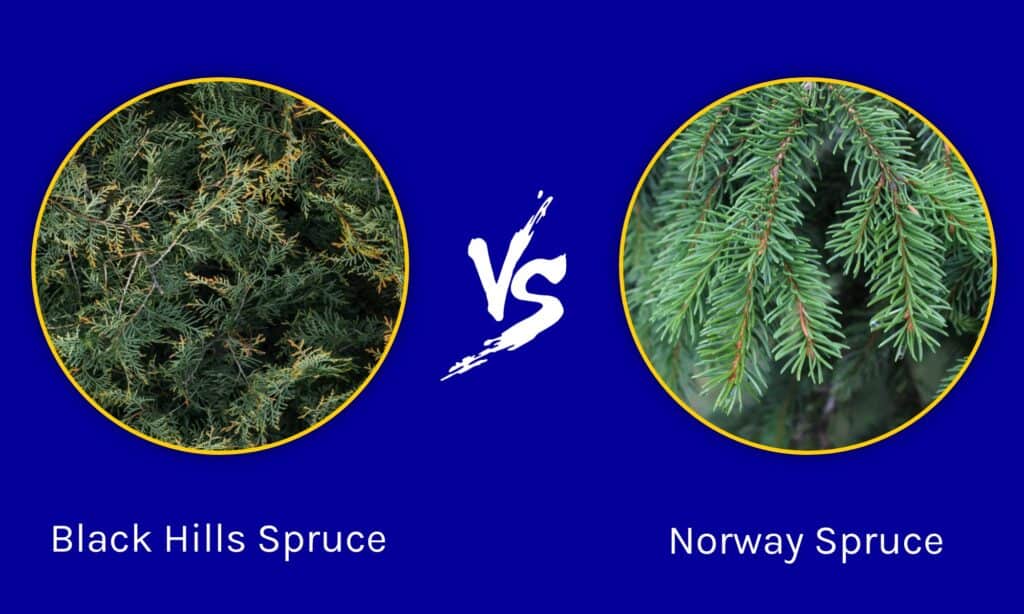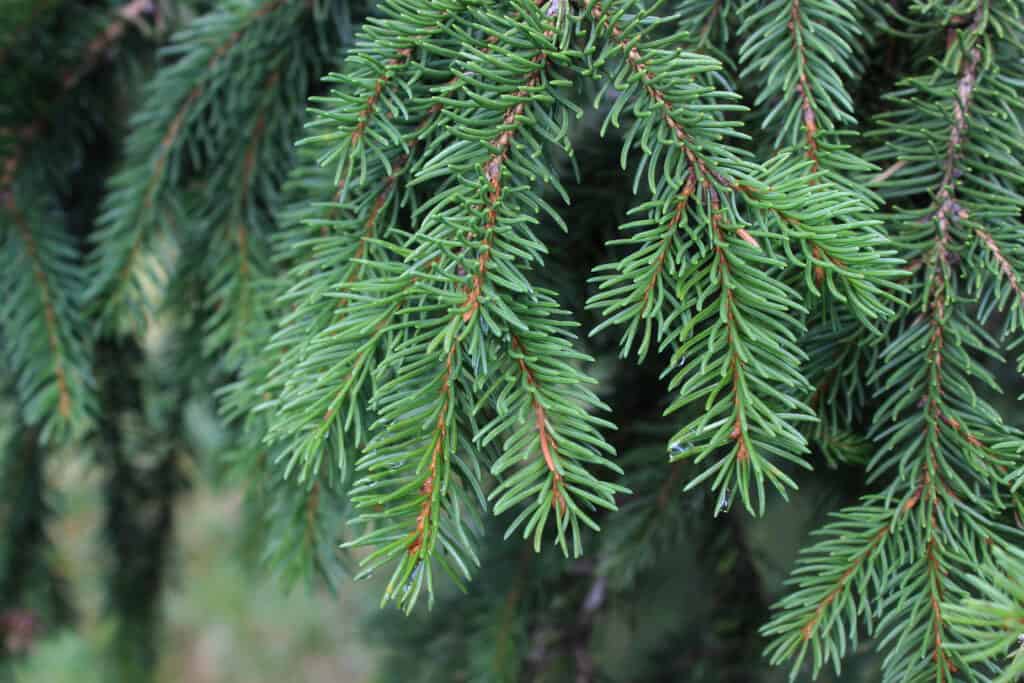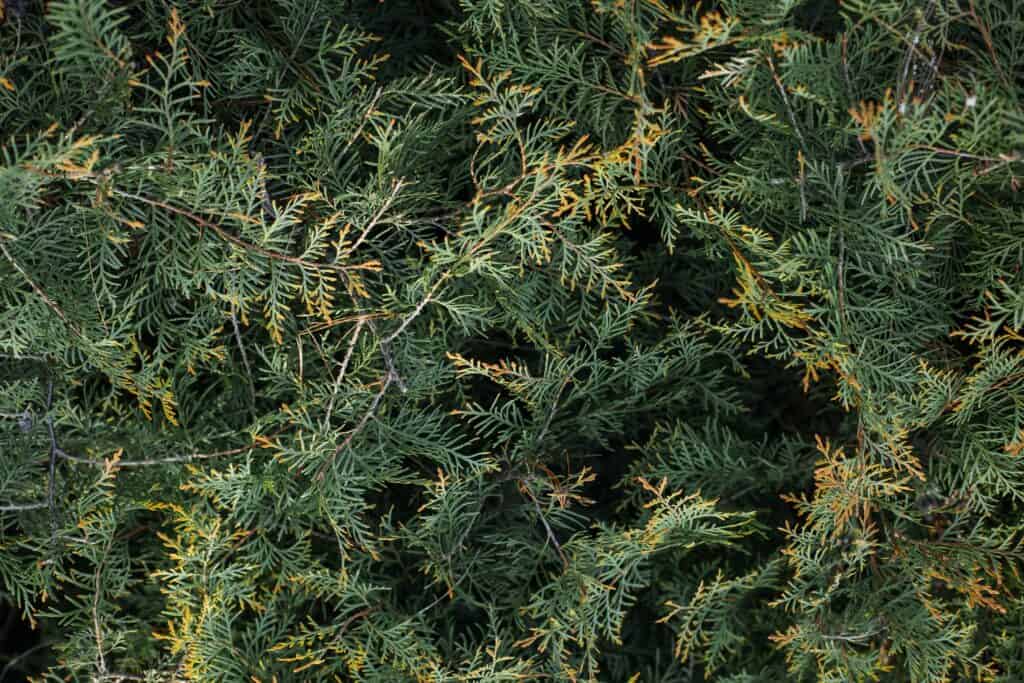Spruce trees are evergreen coniferous trees that grow in pyramid-like shapes. They are evergreen because their leaves remain attached to their foliage throughout the year, and coniferous because they produce cones. Coniferous forests are home to ants, beetles, and other insects that build their nests on dense trees. Deers and elks often hunt for herbivorous food in coniferous forests, so predators like bears and wolves roam here to hunt for prey.
There are many variations of spruce trees. Some species can develop into tall trees, but others are used as bonsai. The largest spruce tree in the world measures about 191 feet tall.
Are you still deciding which tree is suitable for your garden? Do you want to know which species will thrive in your location? Here is a comparison between Black Hills spruce vs. Norway spruce.
Comparing Black Hills Spruce vs. Norway Spruce

| Black Hills Spruce | Norway Spruce | |
|---|---|---|
| Classification | Kingdom: Plantae Clade: Tracheophytes Clade: Gymnosperms Division: Pinophyta Class: Pinopsida Order: Pinales Family: Pinaceae Genus: Picea Species: Picea glauca Variety: Picea glauca var. Densata | Kingdom: Plantae Clade: Tracheophytes Clade: Gymnosperms Division: Pinophyta Class: Pinopsida Order: Pinales Family: Pinaceae Genus: Picea Species: Picea abies |
| Plant Type | Evergreen coniferous tree | Evergreen coniferous tree |
| Origin and Distribution | Black Hills, South Dakota | Throughout Europe |
| Size | Height: 82 to 164 ft (25 to 50 m) | Height: 115 to 180 ft (35 to 55 m) |
| Growth rate | Slow | Moderate to fast |
| Habitat | Coniferous forests | Coniferous forests |
| Hardiness Zone | Hardiness Zones 2–6 | Hardiness Zones 3–7 |
| Elevation (Distance above sea level) | Upper elevation limit: 6,890 ft (2,100 m) | Upper elevation limit: 6,561 feet (2,000 m) |
The Key Differences Between Black Hills Spruce vs. Norway Spruce
There are many differences between the Black Hills spruce and Norway spruce. Black Hills spruce grows at a slower rate compared to Norway spruce. In addition, their leaves, more commonly called ‘needles,’ are different in color, texture, and size.
Here are the key differences between Black Hills spruce and Norway spruce!
Black Hills Spruce vs. Norway Spruce: Classification

Norway spruce is an accepted species in the
Piceagenus.
©KawaiiS/Shutterstock.com
Black Hills spruce, scientifically named Picea glauca var. Densata, is an unofficial variety of the white spruce (Picea glauca) found in an isolated mountain range in South Dakota called the Black Hills. Other studies say that some experts call this tree Picea glauca ‘Densata’ because there aren’t enough differences between Black Hills spruce and white spruce to be accepted as a variety.
Norway spruce, scientifically named Picea abies, is an accepted species in the Picea genus. Picea is a genus of spruce trees. According to records, there are 37 accepted species in this genus.
Black Hills Spruce vs. Norway Spruce: Origin
Black Hills spruce trees are native to an isolated mountain range in South Dakota called the Black Hills, hence its name. It is also the state tree of South Dakota. Other sources say that Black Hills spruce can either be a botanical variation or a cultivar because it has a distinct growth form that is preserved even if the tree is planted in a different location.
Norway spruce does grow in Norway, but its natural distribution is not limited to the country. Studies show that Norway spruce grows throughout the European Alps and was introduced to the Americas in the 18th century. Historically, this tree has been used as an ornamental plant and for a windbreak. It’s a favorite Christmas tree in the US. In fact, it became a national tradition to put up a Norway spruce in Rockefeller Center in Midtown Manhattan, New York City.
Black Hills Spruce vs. Norway Spruce: Hardiness Zone
The Hardiness Zone Map is a standard geographic zone map that contains relevant information indicating whether a plant will or will not survive in a specific location. In 2012, the USDA updated 13 geographic zones based on the average annual minimum temperature from the last 30 years.
The hardiness zone map changes from time to time. But that does not mean you must pull out your plants from your garden every time the map changes. What’s already thriving in your yard will most likely survive if there are minor changes regarding the hardiness zone. But if you are thinking of planting a non-native plant in your garden, this map is the guide. According to the USDA Plant Hardiness Zone Map, Black Hills spruce thrives in Zones 2 to 6, while Norway spruce thrives in Zones 3 to 7.
Black Hills Spruce vs. Norway Spruce: Size

Native Norway spruce trees grow to about 115 to 180 ft (35 to 55 m) tall.
©Jovana Pantovic/Shutterstock.com
Native Black Hills spruce trees range to a height of about 82 to 164 ft (25 to 50 m). Native Norway spruce trees grow to about 115 to 180 ft (35 to 55 m) tall. Records from 2019 show that the tallest Norway spruce is found in Slovenia and is 205.7 ft (62.7 m) tall.
Black Hills Spruce vs. Norway Spruce: Needles (Leaves)
Black Hills spruce have a combination of dark green and dark blue needles. These needles are sharp, pointy, and very hard to bend. They are about 0.3 to 0.75 inches (0.7 to 1.9 centimeters) long. The needles are arranged in a spiral form.
Norway spruce also has needle-like leaves attached to its branches that grow in an upward curve. Its needles grow in a spiral formation. However, Norway spruce needles are longer than those of a Black Hills spruce. These dark green needles grow up to 0.5 – 1 inch (1.5 to 2.5 centimeters) long.
Black Hills Spruce vs. Norway Spruce: Cones

Black Hills spruce has green or purplish female cones and tan to pale red male cones.
©Ua_Biologist/Shutterstock.com
Spruce trees are monoecious plants. This means that once they reach maturity, they can produce both male and female cones, scientifically called strobili. Male strobili produce pollen that fertilizes female strobili. Female cones are usually found on the top of the tree, while male cones are spread throughout the whole tree. Nature’s design on the cones’ placement is perfect so that the wind can carry the pollen up to the female strobili. This process is also known as wind pollination.
The reproduction process for Black Hills spruce and Norway spruce is similar, but their cones are different. According to sources, Black Hills spruce has green or purplish female cones and tan to pale red male cones. Mature cones are about 1 to 2 inches (2.5 to 5 centimeters) long.
Studies show that young female strobili of Norway spruce trees range from soft rose-pink to a deep burgundy. It typically grows upright on the upper parts of the tree. Male strobili are smaller and have yellow shades. Once they mature, they gradually turn downward and grow 4 to 6 inches (10 to 15 centimeters) long. Mature cones range between brown and light brown.
Black Hills Spruce vs. Norway Spruce: Growth Rate
Black Hills spruce grows at a slow rate. Its height increases by less than 12 inches (30.5 centimeters) annually. Norway spruce is the fastest-growing spruce tree. It adds about 13 inches (33 centimeters) to more than 24 inches (61 centimeters) to its height every year.
Up Next:
- Norway Spruce vs. Blue Spruce: What’s the Difference?
- White Spruce vs. Blue Spruce: What’s the Difference?
- Discover the 11 Different Types of Spruce Trees
The photo featured at the top of this post is © ClubhouseArts/Shutterstock.com
Sources
- Yale Nature Walk, Available here: https://naturewalk.yale.edu/trees/pinaceae/picea-abies/norway-spruce-92
- Arbor Day Foundation, Available here: https://www.arborday.org/trees/treeguide/TreeDetail.cfm?ItemID=924
- National Park Service, Available here: https://www.nps.gov/places/000/quinault-big-sitka-spruce-tree.htm
Thank you for reading! Have some feedback for us? Contact the AZ Animals editorial team.






